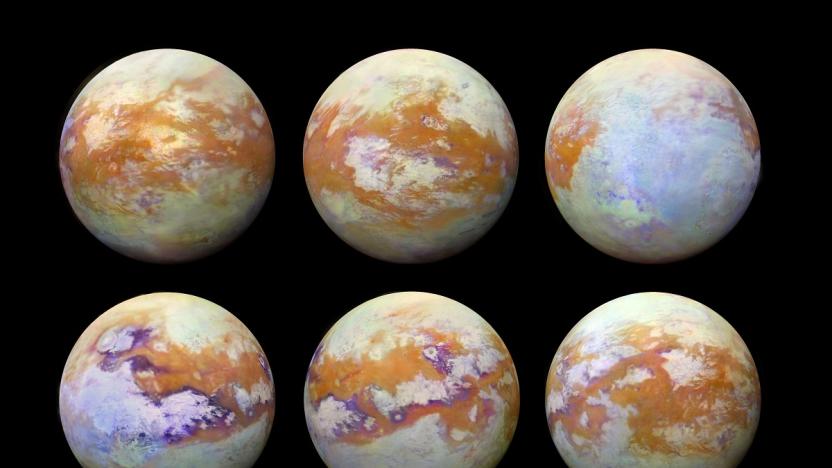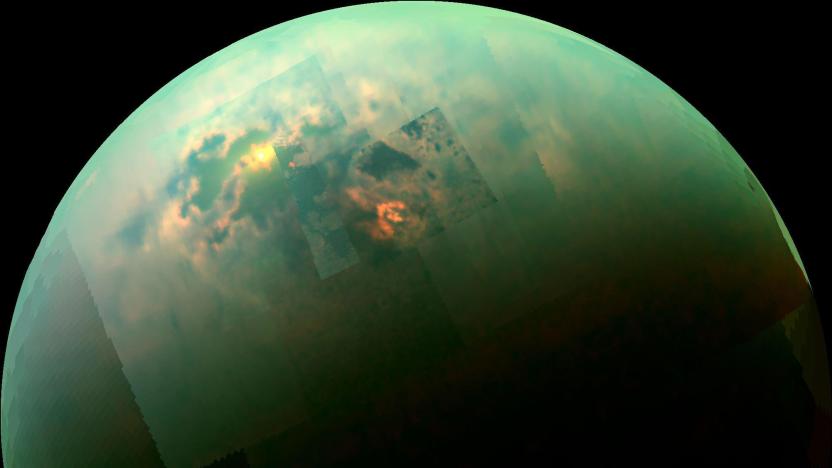cassinispacecraft
Latest

Breathtaking photos show Saturn's moon in a new light
Photos of Saturn's largest moon, Titan, have typically captured the muted, apricot tones of its nitrogen-rich atmosphere. But thanks to more than a decade of data gathered by the Cassini spacecraft, new photographs of an atmosphere-free Titan can show us the mesmerizing beauty of its surface.

ICYMI: A prosthetic hand with two senses
Today on In Case You Missed It: We get our first close-up look at Saturn's rings thanks to the Cassini spacecraft -- which just completed the first of its twenty-two passes through the planets' famed hoops. NASA stitched together the images from the craft to give us Earthlings an incredible first-person (first-spacecraft?) point-of-view of the recent dive, which began at the north pole of the planet and moved down its side. The imaging team working on Cassini's trips expects to get even better data from the subsequent trips, which will gather information on Saturn's gravity and magnetic fields.

ICYMI: Pinchers more powerful than dog jaws
try{document.getElementById("aol-cms-player-1").style.display="none";}catch(e){}Today on In Case You Missed It: Scientists looking into the strength of the pinchers in Coconut crabs found that they exert a force of 3,300 Newtons, which is more than the average dog's jaw and far stronger than any other crustacean. Meanwhile, NASA's plan for the Cassini spacecraft involves getting closer and closer to Saturn's rings as it uses the last of its fuel reserves, then making a fiery plunge into its atmosphere in April of next year. If you're feeling brave, feel free to watch the video of the bike going across the top of a dam, although a personal favorite is the salmon launcher. As always, please share any interesting tech or science videos you find by using the #ICYMI hashtag on Twitter for @mskerryd.

Cassini flybys probe the depths of Titan's methane sea
As Cassini makes the final rounds of Saturn on its roughly 20-year mission, the spacecraft has maneuvered into position over Titan to explore Ligeia Mare, the second-largest methane sea on the planet's largest moon.

NASA releases gorgeous image of Saturn's moon Dione
NASA today released a new image of Dione, one of Saturn's many moons, as the spacecraft responsible for the shots moved into the next phases of its assignment. The visible light photograph displays the many craters and ice cliffs on Dione's surface. The Cassini spacecraft, named for the Italian astronomer who discovered Dione in 1684, has been touring Saturn and its many moons for the last 11 years and has already produced dozens of stunning pictures. Most recently, it completed five flybys of Dione, with the fifth at only 295 miles --the closest distance of the bunch.

Journey through the cosmos with In Saturn's Rings, heading to IMAX in 2014 (video)
Ever since NASA's Cassini-Huygens spacecraft entered Saturn's orbit in 2004, filmmaker Stephen van Vuuren has been enthralled with its progress. So much so that he's spent years collecting over a million insanely high-res photos from Cassini's mission and quilted them together into a 45-minute film called In Saturn's Rings. Without relying on CGI or fancy visual effects, van Vuuren has patched together a seamless visual journey through our solar system, culminating in a breathtaking view of Saturn's rings and moons. Distributed by BIG & Digital, the movie is expected to make its way to IMAX theaters sometime in 2014, though there's no word yet on a specific release date. The first official trailer dropped today, and you can watch it -- in 4K if you've got the right screen -- after the break.

NASA creates the first topographic map of Titan, Saturn's largest moon
Scientists observing Saturn's moon Titan with NASA's Cassini spacecraft have boldly gone where no man has gone before -- visually, anyway. Using radar imagery collected from nine years of Cassini flybys, researchers were able to patch together the first global topographic map of Titan, published in the July 2013 issue of Icarus. Ralph Lorenz, a member of the Cassini radar team at Johns Hopkins, said, "Titan has so much interesting activity -- like flowing liquids and moving sand dunes -- but to understand these processes it's useful to know how the terrain slopes." In particular, understanding the moon's terrain can reveal a lot about its dynamic climate system. Like Earth, Titan's atmosphere is composed primarily of nitrogen, but the liquids and vapors on the moon's surface are made of methane and other organic chemicals integral to the creation of complex life. By studying the relationship between atmosphere and terrain, researchers hope to learn more about the evolution of life in its earliest stages, and inspire curious minds to turn their eyes toward Titan.

Visualized: Space hurricane! NASA's Cassini records super cyclone on Saturn (video)
If the crashing sound of lightning striking Saturn wasn't enough to excite your inner-meteorologist, then perhaps footage of a raging extraterrestrial hurricane will win you over. After orbiting the ringed planet for nine years, NASA's Cassini probe has managed to snag video of a super storm on the celestial body's north pole. Cloaked by the darkness of winter, the hurricane's eye became visible as Saturn's northern hemisphere transitioned into spring. Unlike the tropical cyclones of Earth (see: Hurricane Katrina, Sandy and Irene), this furious typhoon has been spinning for several years and has winds that flow at speeds exceeding 300MPH. Further differentiating itself from our world's whirlwinds, this alien cyclone is locked to its planet's north pole and is fueled by small amounts of water vapor instead of an actual ocean. Completely in a category of its own, the hurricane's eye measures about 1,250 miles wide and is surrounded by fluffy white clouds the size of Texas. To see this Saturnian fury in all its glory, check out the video after the break and feel free to leave your gratuitous hurricane names in the comments below.




